HI6028 Taxation Theory, Practice & Law T2 2017 Individual Assignment
VerifiedAdded on 2020/04/01
|9
|1683
|55
Homework Assignment
AI Summary
This document presents a detailed solution to an individual assignment for the HI6028 Taxation Theory, Practice & Law course. The assignment addresses various taxation issues, including capital gains tax, fringe benefits tax (FBT), and the allocation of losses among contractual parties. It examines the application of Australian taxation provisions, such as determining taxable amounts based on holding periods, calculating FBT on loans, and the treatment of rental property income. The solution also explores legal principles like the Duke of Westminster principle and its relevance in the current Australian legal environment. Furthermore, the assignment analyzes the taxability of earnings from the disposal of standing timber under different scenarios, referencing relevant taxation rulings. The document provides calculations, legal provisions, and conclusions for each question, offering a comprehensive understanding of the taxation concepts covered in the assignment.
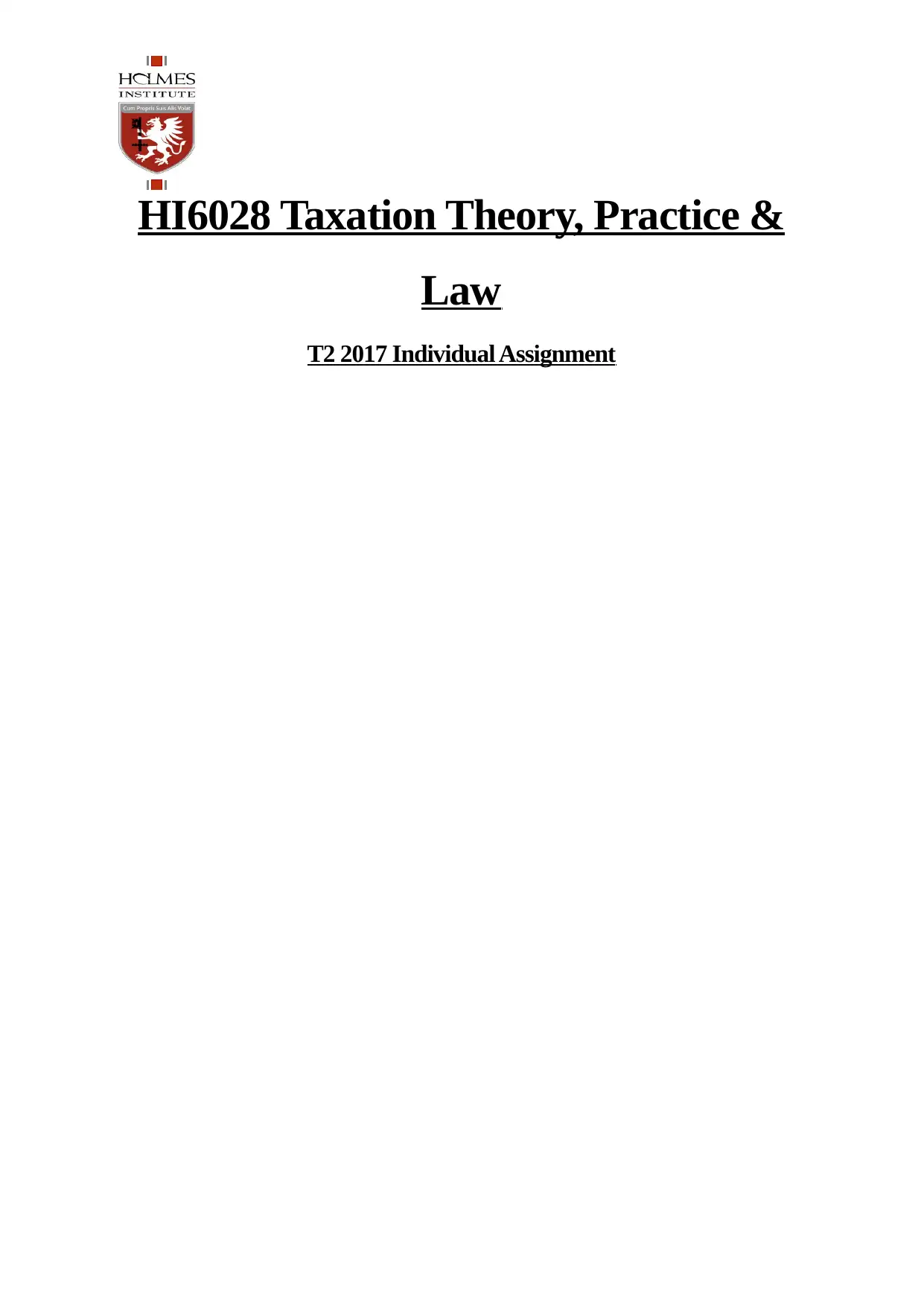
HI6028 Taxation Theory, Practice &
Law
T2 2017 Individual Assignment
Law
T2 2017 Individual Assignment
Paraphrase This Document
Need a fresh take? Get an instant paraphrase of this document with our AI Paraphraser
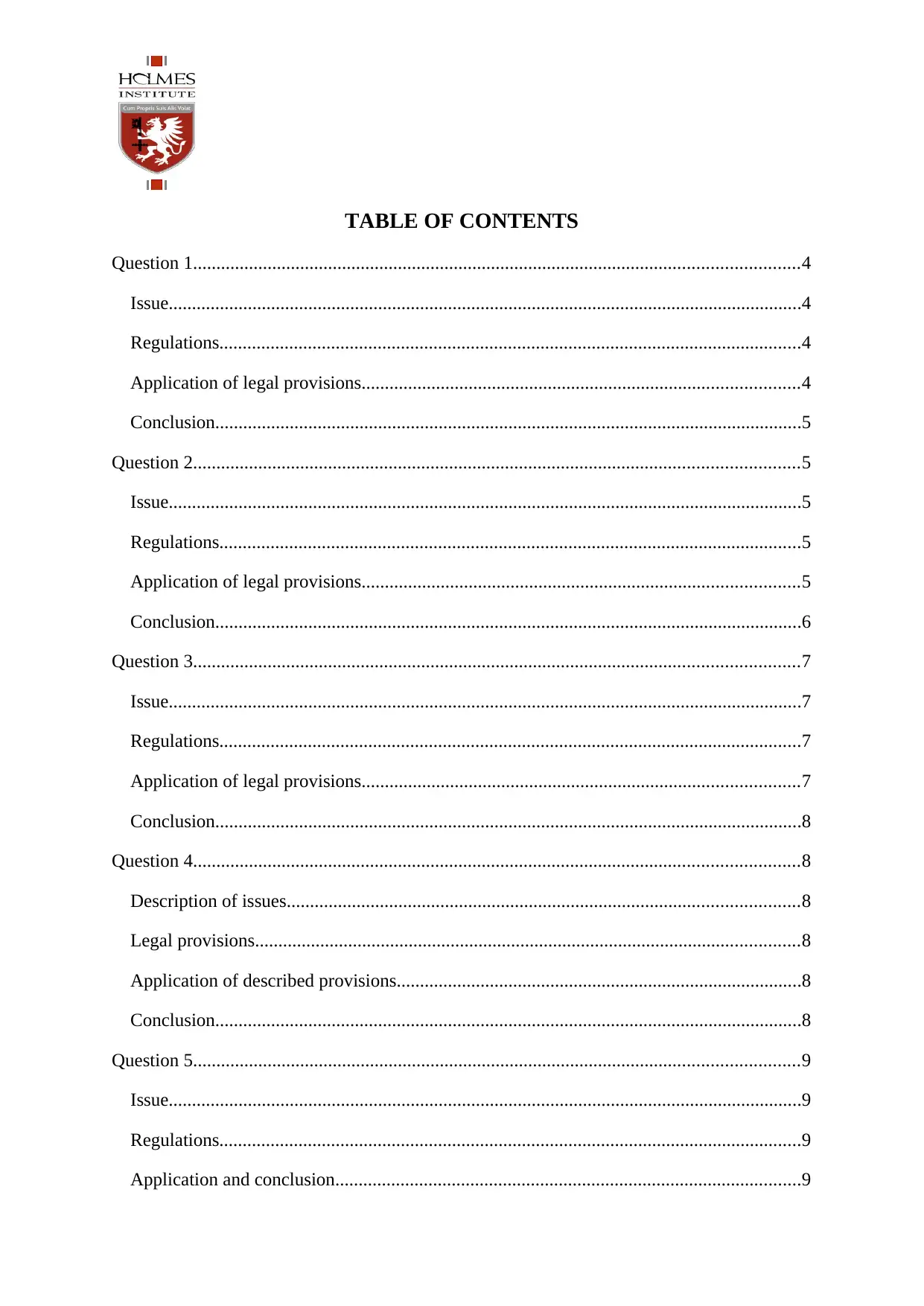
TABLE OF CONTENTS
Question 1..................................................................................................................................4
Issue........................................................................................................................................4
Regulations.............................................................................................................................4
Application of legal provisions..............................................................................................4
Conclusion..............................................................................................................................5
Question 2..................................................................................................................................5
Issue........................................................................................................................................5
Regulations.............................................................................................................................5
Application of legal provisions..............................................................................................5
Conclusion..............................................................................................................................6
Question 3..................................................................................................................................7
Issue........................................................................................................................................7
Regulations.............................................................................................................................7
Application of legal provisions..............................................................................................7
Conclusion..............................................................................................................................8
Question 4..................................................................................................................................8
Description of issues..............................................................................................................8
Legal provisions.....................................................................................................................8
Application of described provisions.......................................................................................8
Conclusion..............................................................................................................................8
Question 5..................................................................................................................................9
Issue........................................................................................................................................9
Regulations.............................................................................................................................9
Application and conclusion....................................................................................................9
Question 1..................................................................................................................................4
Issue........................................................................................................................................4
Regulations.............................................................................................................................4
Application of legal provisions..............................................................................................4
Conclusion..............................................................................................................................5
Question 2..................................................................................................................................5
Issue........................................................................................................................................5
Regulations.............................................................................................................................5
Application of legal provisions..............................................................................................5
Conclusion..............................................................................................................................6
Question 3..................................................................................................................................7
Issue........................................................................................................................................7
Regulations.............................................................................................................................7
Application of legal provisions..............................................................................................7
Conclusion..............................................................................................................................8
Question 4..................................................................................................................................8
Description of issues..............................................................................................................8
Legal provisions.....................................................................................................................8
Application of described provisions.......................................................................................8
Conclusion..............................................................................................................................8
Question 5..................................................................................................................................9
Issue........................................................................................................................................9
Regulations.............................................................................................................................9
Application and conclusion....................................................................................................9

References................................................................................................................................10
⊘ This is a preview!⊘
Do you want full access?
Subscribe today to unlock all pages.

Trusted by 1+ million students worldwide
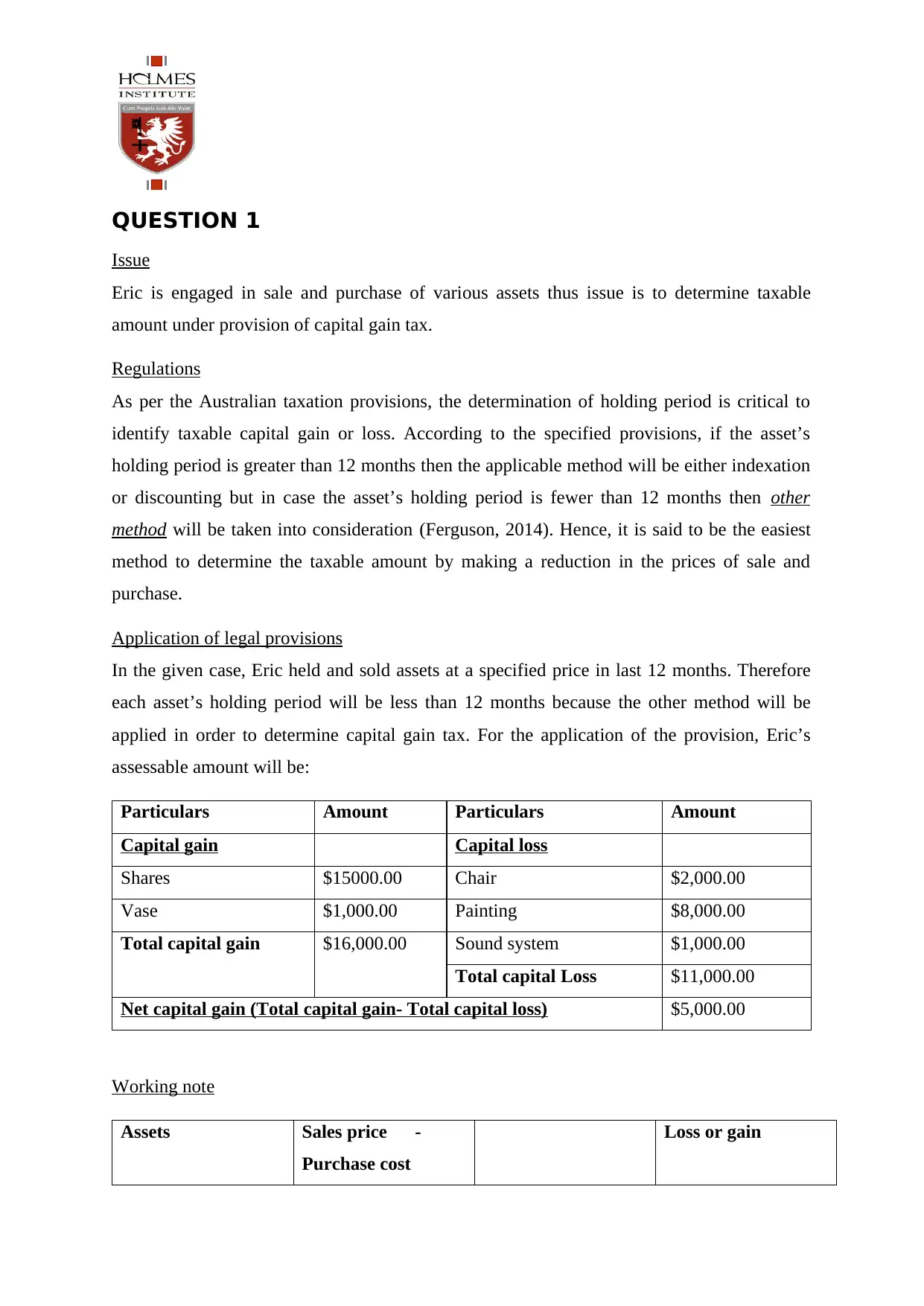
QUESTION 1
Issue
Eric is engaged in sale and purchase of various assets thus issue is to determine taxable
amount under provision of capital gain tax.
Regulations
As per the Australian taxation provisions, the determination of holding period is critical to
identify taxable capital gain or loss. According to the specified provisions, if the asset’s
holding period is greater than 12 months then the applicable method will be either indexation
or discounting but in case the asset’s holding period is fewer than 12 months then other
method will be taken into consideration (Ferguson, 2014). Hence, it is said to be the easiest
method to determine the taxable amount by making a reduction in the prices of sale and
purchase.
Application of legal provisions
In the given case, Eric held and sold assets at a specified price in last 12 months. Therefore
each asset’s holding period will be less than 12 months because the other method will be
applied in order to determine capital gain tax. For the application of the provision, Eric’s
assessable amount will be:
Particulars Amount Particulars Amount
Capital gain Capital loss
Shares $15000.00 Chair $2,000.00
Vase $1,000.00 Painting $8,000.00
Total capital gain $16,000.00 Sound system $1,000.00
Total capital Loss $11,000.00
Net capital gain (Total capital gain- Total capital loss) $5,000.00
Working note
Assets Sales price -
Purchase cost
Loss or gain
Issue
Eric is engaged in sale and purchase of various assets thus issue is to determine taxable
amount under provision of capital gain tax.
Regulations
As per the Australian taxation provisions, the determination of holding period is critical to
identify taxable capital gain or loss. According to the specified provisions, if the asset’s
holding period is greater than 12 months then the applicable method will be either indexation
or discounting but in case the asset’s holding period is fewer than 12 months then other
method will be taken into consideration (Ferguson, 2014). Hence, it is said to be the easiest
method to determine the taxable amount by making a reduction in the prices of sale and
purchase.
Application of legal provisions
In the given case, Eric held and sold assets at a specified price in last 12 months. Therefore
each asset’s holding period will be less than 12 months because the other method will be
applied in order to determine capital gain tax. For the application of the provision, Eric’s
assessable amount will be:
Particulars Amount Particulars Amount
Capital gain Capital loss
Shares $15000.00 Chair $2,000.00
Vase $1,000.00 Painting $8,000.00
Total capital gain $16,000.00 Sound system $1,000.00
Total capital Loss $11,000.00
Net capital gain (Total capital gain- Total capital loss) $5,000.00
Working note
Assets Sales price -
Purchase cost
Loss or gain
Paraphrase This Document
Need a fresh take? Get an instant paraphrase of this document with our AI Paraphraser
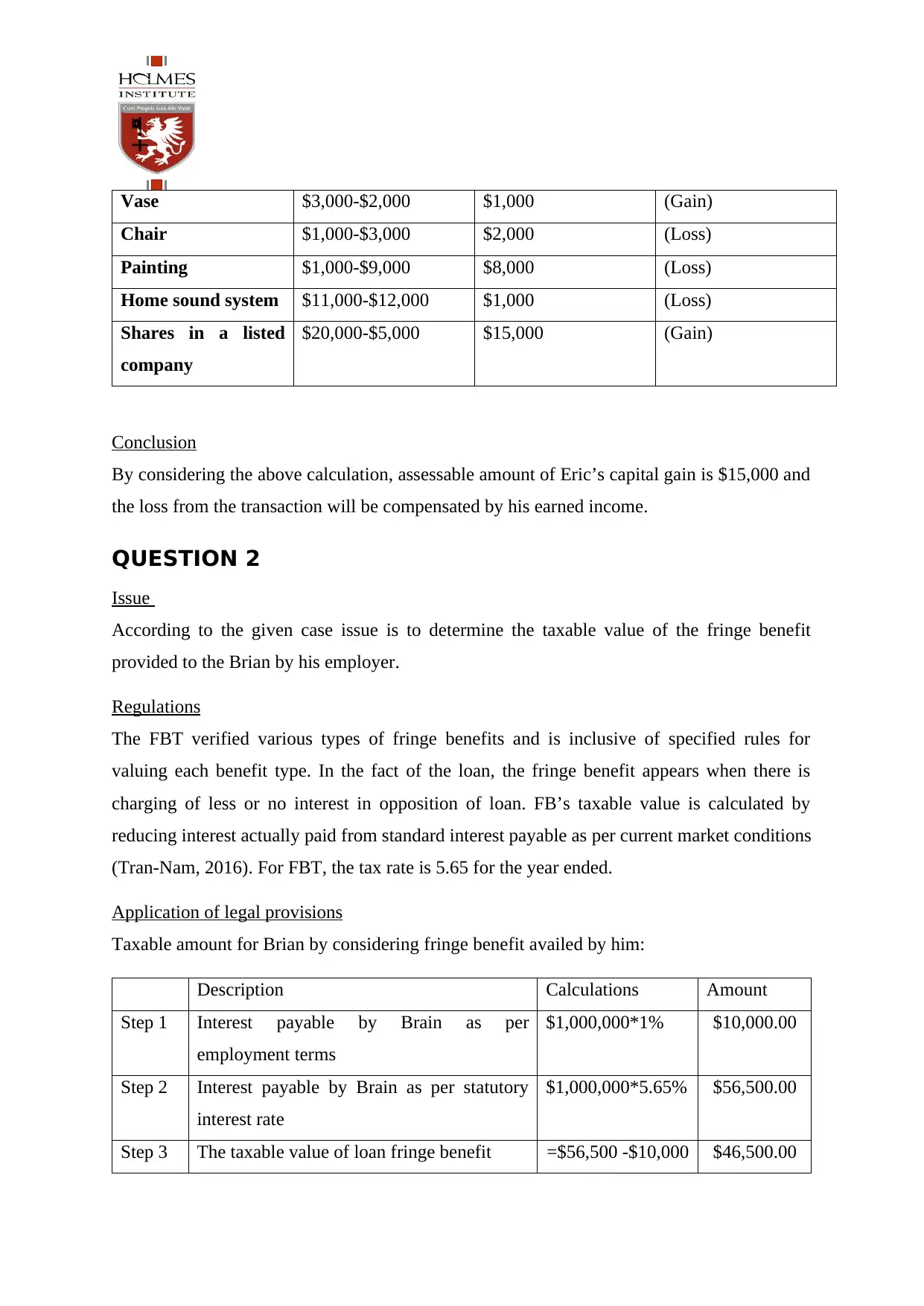
Vase $3,000-$2,000 $1,000 (Gain)
Chair $1,000-$3,000 $2,000 (Loss)
Painting $1,000-$9,000 $8,000 (Loss)
Home sound system $11,000-$12,000 $1,000 (Loss)
Shares in a listed
company
$20,000-$5,000 $15,000 (Gain)
Conclusion
By considering the above calculation, assessable amount of Eric’s capital gain is $15,000 and
the loss from the transaction will be compensated by his earned income.
QUESTION 2
Issue
According to the given case issue is to determine the taxable value of the fringe benefit
provided to the Brian by his employer.
Regulations
The FBT verified various types of fringe benefits and is inclusive of specified rules for
valuing each benefit type. In the fact of the loan, the fringe benefit appears when there is
charging of less or no interest in opposition of loan. FB’s taxable value is calculated by
reducing interest actually paid from standard interest payable as per current market conditions
(Tran-Nam, 2016). For FBT, the tax rate is 5.65 for the year ended.
Application of legal provisions
Taxable amount for Brian by considering fringe benefit availed by him:
Description Calculations Amount
Step 1 Interest payable by Brain as per
employment terms
$1,000,000*1% $10,000.00
Step 2 Interest payable by Brain as per statutory
interest rate
$1,000,000*5.65% $56,500.00
Step 3 The taxable value of loan fringe benefit =$56,500 -$10,000 $46,500.00
Chair $1,000-$3,000 $2,000 (Loss)
Painting $1,000-$9,000 $8,000 (Loss)
Home sound system $11,000-$12,000 $1,000 (Loss)
Shares in a listed
company
$20,000-$5,000 $15,000 (Gain)
Conclusion
By considering the above calculation, assessable amount of Eric’s capital gain is $15,000 and
the loss from the transaction will be compensated by his earned income.
QUESTION 2
Issue
According to the given case issue is to determine the taxable value of the fringe benefit
provided to the Brian by his employer.
Regulations
The FBT verified various types of fringe benefits and is inclusive of specified rules for
valuing each benefit type. In the fact of the loan, the fringe benefit appears when there is
charging of less or no interest in opposition of loan. FB’s taxable value is calculated by
reducing interest actually paid from standard interest payable as per current market conditions
(Tran-Nam, 2016). For FBT, the tax rate is 5.65 for the year ended.
Application of legal provisions
Taxable amount for Brian by considering fringe benefit availed by him:
Description Calculations Amount
Step 1 Interest payable by Brain as per
employment terms
$1,000,000*1% $10,000.00
Step 2 Interest payable by Brain as per statutory
interest rate
$1,000,000*5.65% $56,500.00
Step 3 The taxable value of loan fringe benefit =$56,500 -$10,000 $46,500.00
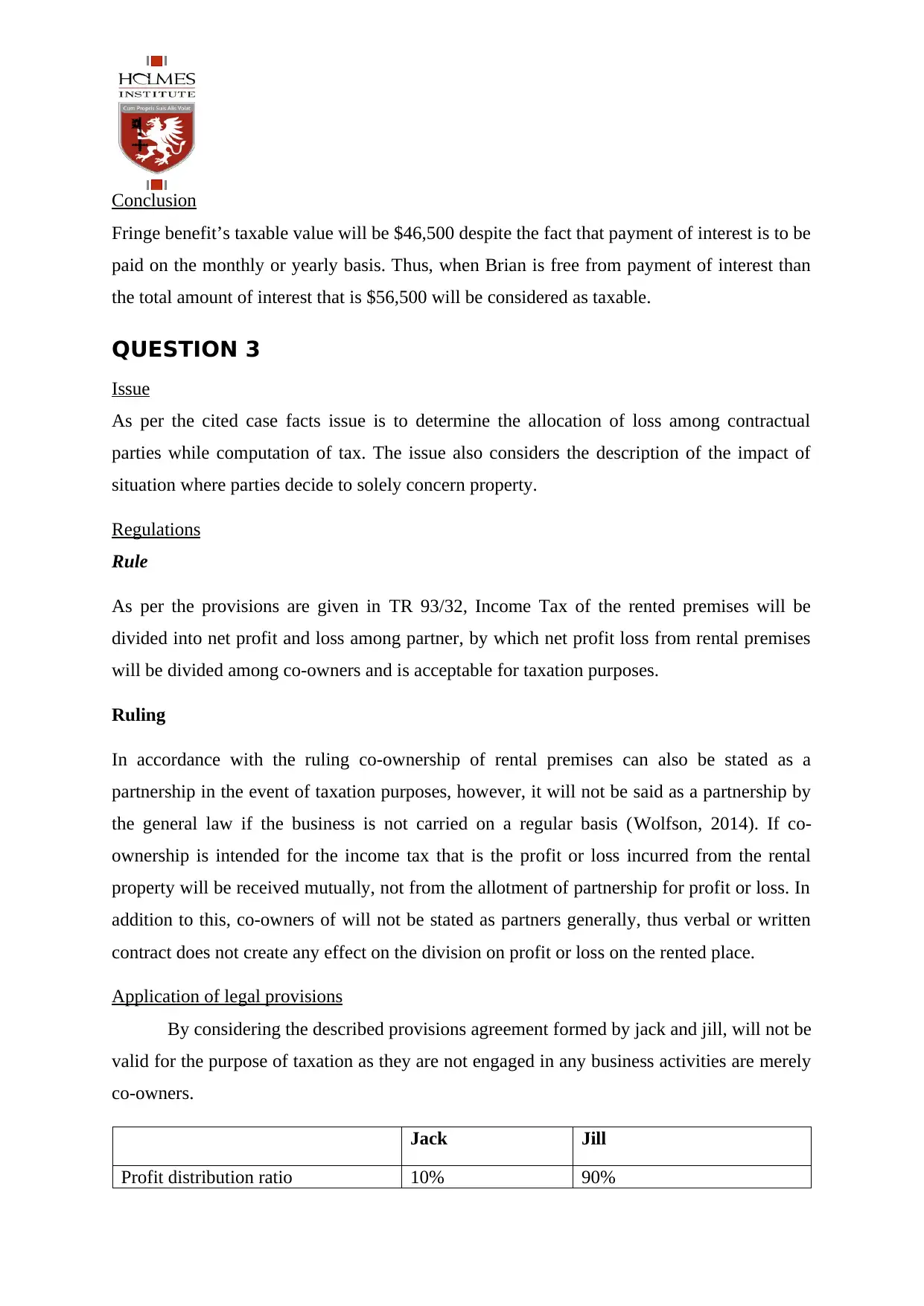
Conclusion
Fringe benefit’s taxable value will be $46,500 despite the fact that payment of interest is to be
paid on the monthly or yearly basis. Thus, when Brian is free from payment of interest than
the total amount of interest that is $56,500 will be considered as taxable.
QUESTION 3
Issue
As per the cited case facts issue is to determine the allocation of loss among contractual
parties while computation of tax. The issue also considers the description of the impact of
situation where parties decide to solely concern property.
Regulations
Rule
As per the provisions are given in TR 93/32, Income Tax of the rented premises will be
divided into net profit and loss among partner, by which net profit loss from rental premises
will be divided among co-owners and is acceptable for taxation purposes.
Ruling
In accordance with the ruling co-ownership of rental premises can also be stated as a
partnership in the event of taxation purposes, however, it will not be said as a partnership by
the general law if the business is not carried on a regular basis (Wolfson, 2014). If co-
ownership is intended for the income tax that is the profit or loss incurred from the rental
property will be received mutually, not from the allotment of partnership for profit or loss. In
addition to this, co-owners of will not be stated as partners generally, thus verbal or written
contract does not create any effect on the division on profit or loss on the rented place.
Application of legal provisions
By considering the described provisions agreement formed by jack and jill, will not be
valid for the purpose of taxation as they are not engaged in any business activities are merely
co-owners.
Jack Jill
Profit distribution ratio 10% 90%
Fringe benefit’s taxable value will be $46,500 despite the fact that payment of interest is to be
paid on the monthly or yearly basis. Thus, when Brian is free from payment of interest than
the total amount of interest that is $56,500 will be considered as taxable.
QUESTION 3
Issue
As per the cited case facts issue is to determine the allocation of loss among contractual
parties while computation of tax. The issue also considers the description of the impact of
situation where parties decide to solely concern property.
Regulations
Rule
As per the provisions are given in TR 93/32, Income Tax of the rented premises will be
divided into net profit and loss among partner, by which net profit loss from rental premises
will be divided among co-owners and is acceptable for taxation purposes.
Ruling
In accordance with the ruling co-ownership of rental premises can also be stated as a
partnership in the event of taxation purposes, however, it will not be said as a partnership by
the general law if the business is not carried on a regular basis (Wolfson, 2014). If co-
ownership is intended for the income tax that is the profit or loss incurred from the rental
property will be received mutually, not from the allotment of partnership for profit or loss. In
addition to this, co-owners of will not be stated as partners generally, thus verbal or written
contract does not create any effect on the division on profit or loss on the rented place.
Application of legal provisions
By considering the described provisions agreement formed by jack and jill, will not be
valid for the purpose of taxation as they are not engaged in any business activities are merely
co-owners.
Jack Jill
Profit distribution ratio 10% 90%
⊘ This is a preview!⊘
Do you want full access?
Subscribe today to unlock all pages.

Trusted by 1+ million students worldwide
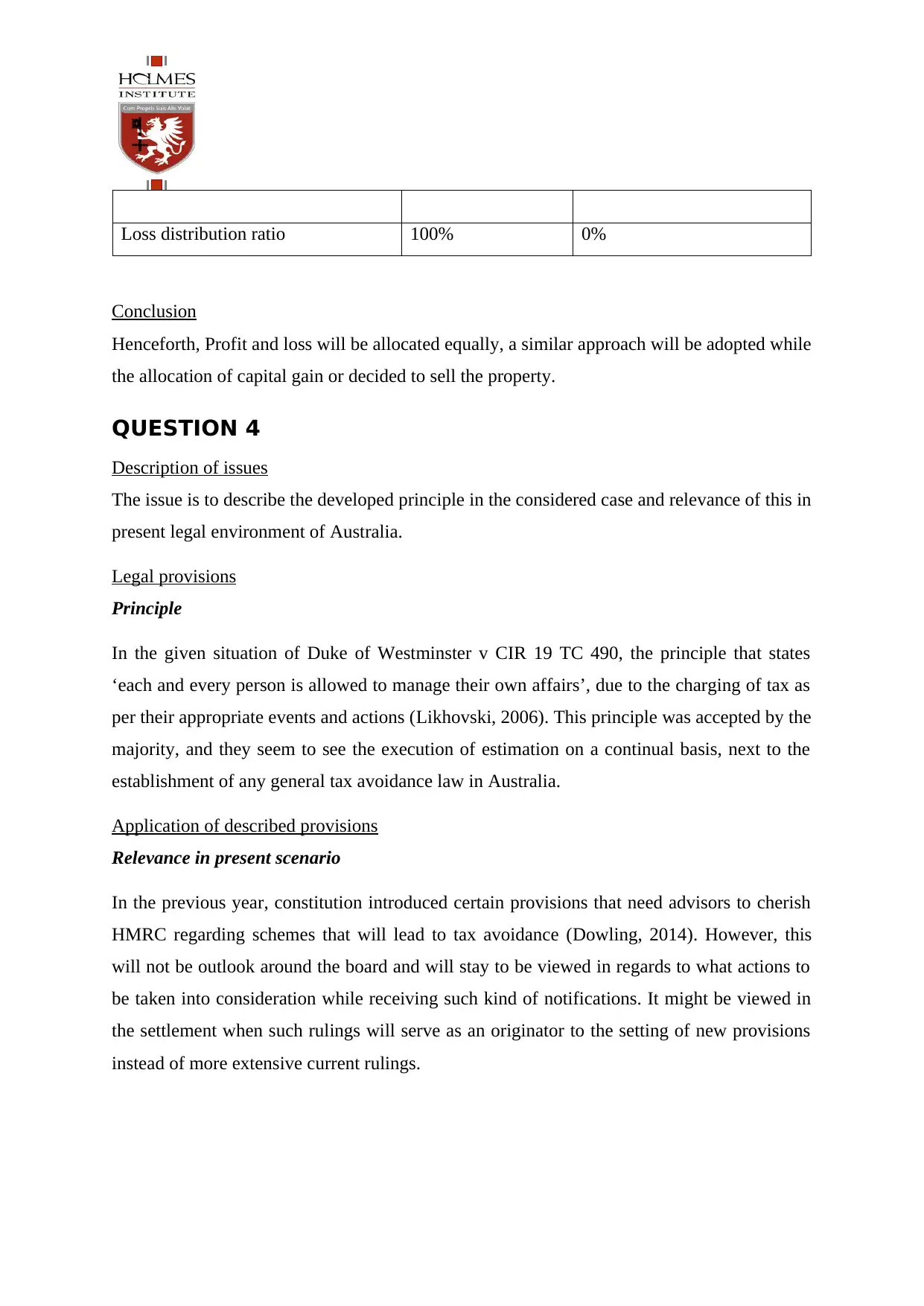
Loss distribution ratio 100% 0%
Conclusion
Henceforth, Profit and loss will be allocated equally, a similar approach will be adopted while
the allocation of capital gain or decided to sell the property.
QUESTION 4
Description of issues
The issue is to describe the developed principle in the considered case and relevance of this in
present legal environment of Australia.
Legal provisions
Principle
In the given situation of Duke of Westminster v CIR 19 TC 490, the principle that states
‘each and every person is allowed to manage their own affairs’, due to the charging of tax as
per their appropriate events and actions (Likhovski, 2006). This principle was accepted by the
majority, and they seem to see the execution of estimation on a continual basis, next to the
establishment of any general tax avoidance law in Australia.
Application of described provisions
Relevance in present scenario
In the previous year, constitution introduced certain provisions that need advisors to cherish
HMRC regarding schemes that will lead to tax avoidance (Dowling, 2014). However, this
will not be outlook around the board and will stay to be viewed in regards to what actions to
be taken into consideration while receiving such kind of notifications. It might be viewed in
the settlement when such rulings will serve as an originator to the setting of new provisions
instead of more extensive current rulings.
Conclusion
Henceforth, Profit and loss will be allocated equally, a similar approach will be adopted while
the allocation of capital gain or decided to sell the property.
QUESTION 4
Description of issues
The issue is to describe the developed principle in the considered case and relevance of this in
present legal environment of Australia.
Legal provisions
Principle
In the given situation of Duke of Westminster v CIR 19 TC 490, the principle that states
‘each and every person is allowed to manage their own affairs’, due to the charging of tax as
per their appropriate events and actions (Likhovski, 2006). This principle was accepted by the
majority, and they seem to see the execution of estimation on a continual basis, next to the
establishment of any general tax avoidance law in Australia.
Application of described provisions
Relevance in present scenario
In the previous year, constitution introduced certain provisions that need advisors to cherish
HMRC regarding schemes that will lead to tax avoidance (Dowling, 2014). However, this
will not be outlook around the board and will stay to be viewed in regards to what actions to
be taken into consideration while receiving such kind of notifications. It might be viewed in
the settlement when such rulings will serve as an originator to the setting of new provisions
instead of more extensive current rulings.
Paraphrase This Document
Need a fresh take? Get an instant paraphrase of this document with our AI Paraphraser
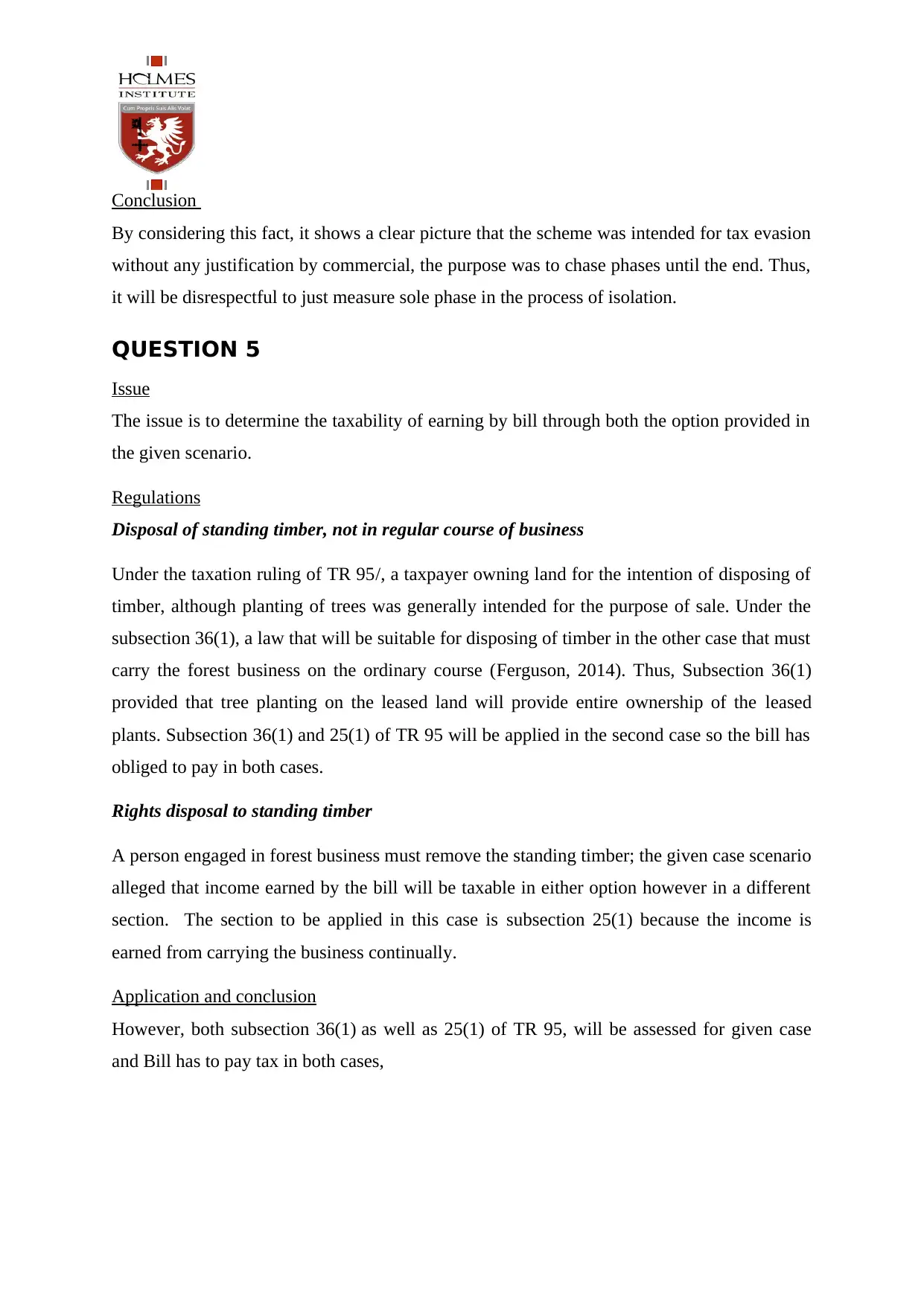
Conclusion
By considering this fact, it shows a clear picture that the scheme was intended for tax evasion
without any justification by commercial, the purpose was to chase phases until the end. Thus,
it will be disrespectful to just measure sole phase in the process of isolation.
QUESTION 5
Issue
The issue is to determine the taxability of earning by bill through both the option provided in
the given scenario.
Regulations
Disposal of standing timber, not in regular course of business
Under the taxation ruling of TR 95/, a taxpayer owning land for the intention of disposing of
timber, although planting of trees was generally intended for the purpose of sale. Under the
subsection 36(1), a law that will be suitable for disposing of timber in the other case that must
carry the forest business on the ordinary course (Ferguson, 2014). Thus, Subsection 36(1)
provided that tree planting on the leased land will provide entire ownership of the leased
plants. Subsection 36(1) and 25(1) of TR 95 will be applied in the second case so the bill has
obliged to pay in both cases.
Rights disposal to standing timber
A person engaged in forest business must remove the standing timber; the given case scenario
alleged that income earned by the bill will be taxable in either option however in a different
section. The section to be applied in this case is subsection 25(1) because the income is
earned from carrying the business continually.
Application and conclusion
However, both subsection 36(1) as well as 25(1) of TR 95, will be assessed for given case
and Bill has to pay tax in both cases,
By considering this fact, it shows a clear picture that the scheme was intended for tax evasion
without any justification by commercial, the purpose was to chase phases until the end. Thus,
it will be disrespectful to just measure sole phase in the process of isolation.
QUESTION 5
Issue
The issue is to determine the taxability of earning by bill through both the option provided in
the given scenario.
Regulations
Disposal of standing timber, not in regular course of business
Under the taxation ruling of TR 95/, a taxpayer owning land for the intention of disposing of
timber, although planting of trees was generally intended for the purpose of sale. Under the
subsection 36(1), a law that will be suitable for disposing of timber in the other case that must
carry the forest business on the ordinary course (Ferguson, 2014). Thus, Subsection 36(1)
provided that tree planting on the leased land will provide entire ownership of the leased
plants. Subsection 36(1) and 25(1) of TR 95 will be applied in the second case so the bill has
obliged to pay in both cases.
Rights disposal to standing timber
A person engaged in forest business must remove the standing timber; the given case scenario
alleged that income earned by the bill will be taxable in either option however in a different
section. The section to be applied in this case is subsection 25(1) because the income is
earned from carrying the business continually.
Application and conclusion
However, both subsection 36(1) as well as 25(1) of TR 95, will be assessed for given case
and Bill has to pay tax in both cases,

section 36(1) will apply if he has obtained the amount of $1000 as income and subsection
25(1) will apply if the payment is made in full.
25(1) will apply if the payment is made in full.
⊘ This is a preview!⊘
Do you want full access?
Subscribe today to unlock all pages.

Trusted by 1+ million students worldwide
1 out of 9
Related Documents
Your All-in-One AI-Powered Toolkit for Academic Success.
+13062052269
info@desklib.com
Available 24*7 on WhatsApp / Email
![[object Object]](/_next/static/media/star-bottom.7253800d.svg)
Unlock your academic potential
Copyright © 2020–2025 A2Z Services. All Rights Reserved. Developed and managed by ZUCOL.





